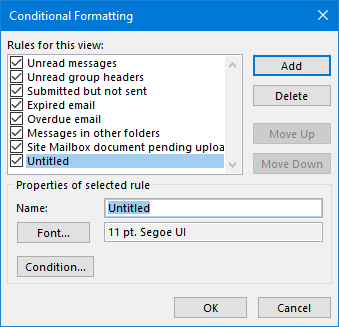

You will see the Unread Messages rule and the blue color. When you create a conditional format, you are apply that formatting to the view you are currently editing. To do this, choose View > View Settings > Conditional Formatting. This can include changing which columns are displayed, the sorting order being used, and you can even apply filters within a view. Each folder within your mailbox has the ability to be customised.

The other thing to remember is that conditional formatting in Outlook is applied to each “view”. Don’t like the default style for unread messages? You can change it via conditional formatting. Enter the desired name for the rule and click Font. A new rule will be created with default name of Untitled. In the Conditional Formatting dialog add a new rule by clicking Add. In the Advanced View Settings dialog box, click Conditional Formatting. To configure Outlook to display all the email in Plain Text by default. From Outlook follow these steps: Click on the View tab. It’s the reason that new emails appear in bold blue font. On the Advanced View Settings dialog box, click Conditional Formatting button. What if you receive email for multiple email accounts and you’d like emails sent to a specific email address to stand out?Ĭonditional formatting is actually already being applied within Outlook.

Maybe you’d like any email which contains a specific word in the subject to be highlighted in red? Want to make all emails from “Bob” go green on arrival? No problems. However, I cannot find where I can do any formatting based on the condition Private. My idea was Conditional Formatting which works well. Whether a category is assigned or only a color is given is not important to me - either one will do. This feature allows you to specify rules based on your incoming email messages so that you can change the formatting as they arrive. In Outlook 2010, In Calendar, I want to give all Private appointments & meetings a color. Many users have discovered the amazing conditional formatting functions available in Excel, but not many know that you can also use conditional formatting in Outlook.


 0 kommentar(er)
0 kommentar(er)
